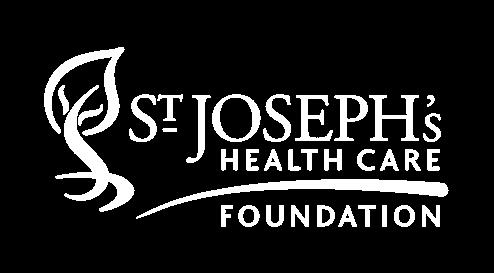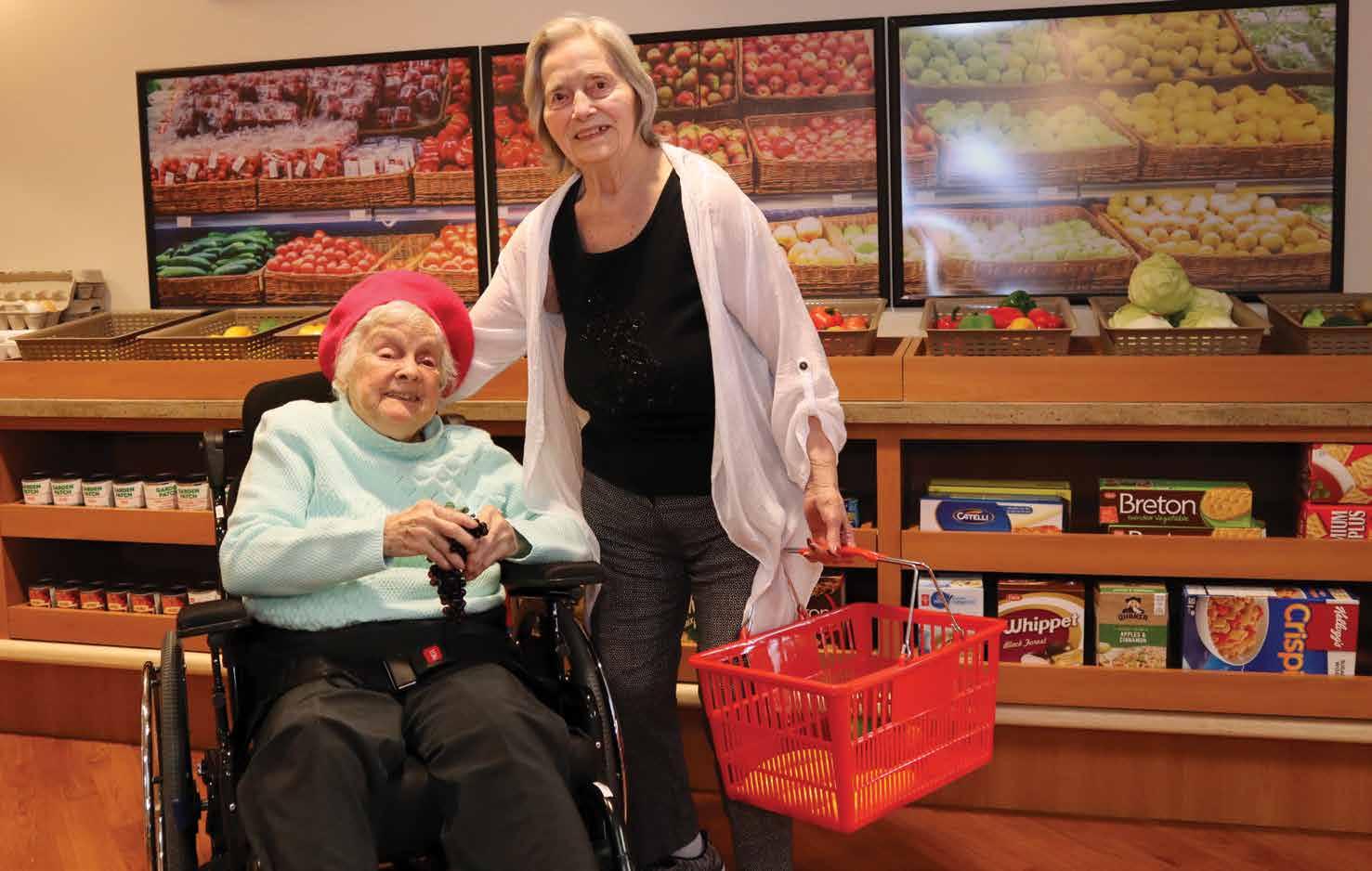
25 minute read
THE THERAPEUTIC POWER OF MEMORY
Joyce May picks grapes with friend Gloria Coffey while enjoying the interactive village at Mount Hope Centre for Long Term Care.
“What kind of pie should we bake?” It’s a question that might seem out of place to some health care providers, but not to Lisa Roselli, who understands how pie, even imaginary, can ignite a “spark of life.”.
In the Memory Care Unit at Mount Hope Centre for Long Term Care, Lisa, a therapeutic recreation assistant, helps 36 residents living with dementia remain active and engaged in a safe environment.
"When residents feel restless, they might wander or become agitated and confused when they can’t leave the unit for their own safety," says Lisa. As a way to calm residents, the care team took inspiration from Hogeweyk in the Netherlands, a secure community setting where people living with dementia can revisit familiar things from their past.
Mount Hope’s Memory Care Unit opens to a farmland mural that transitions into the city, complete with actual street signs and lamps to bring the outside in. From there, residents can visit the post office or watch a movie at the cinema.
“What’s so special about this interactive village is how the simulated activities have a real-life impact,” says Lisa as she recalls a day when a resident was crying and feeling confused. As they both approached the grocery store display in the unit, Lisa asked, “What kind of pie should we bake?”
“Soon the resident was happy and smiling, and we were reminiscing about a time when she was baking apple pies with her grandma in her kitchen,” says Lisa.
Creating the look of a neighbourhood on the unit took paint and props to bring it to life. The team was able to create this unique and compassionate care setting through donations to St. Joseph’s Health Care Foundation.
“Donors have helped bring that spark of life back to our residents,” says Lisa. “Without donor support, this interactive village would not have been possible.”
1
Take a tour through the Memory Care Unit at Mount Hope Centre for Long Term Care at:
www.sjhc.london.on.ca/ foundation
VIRTUAL PATIENT CARE - THE COVID-19
SILVER LINING
Without leaving home, about 1000 patients a day were receiving care, education and therapy through virtual technology across St. Joseph's Health Care London at the peak of the pandemic.
Across St. Joseph’s Heath Care London, teams are rapidly and creatively taking advantage of what they see as the COVID-19 silver lining – the impetus to fast forward virtual patient care to keep patients connected with their care teams.
During the peak of the pandemic, 65 per cent of all registered visits were virtual care appointments, a jump from about six per cent pre-pandemic. The daily weekday average during the peak was 1,000 virtual appointments compared to about 160- a-day pre-pandemic.
SO WHERE DOES VIRTUAL CARE GO FROM HERE?
St. Joseph’s is just at the beginning of this journey, says Glen Kearns, Integrated Vice President, Diagnostic Services and Chief Information Officer.
— GLEN KEARNS, INTEGRATED VICE PRESIDENT, DIAGNOSTIC SERVICES AND CHIEF INFORMATION OFFICER Speech-language pathologist Debra Medzon engages in a dynamic virtual therapy session with a patient who lost his speech due to a devastating stroke.
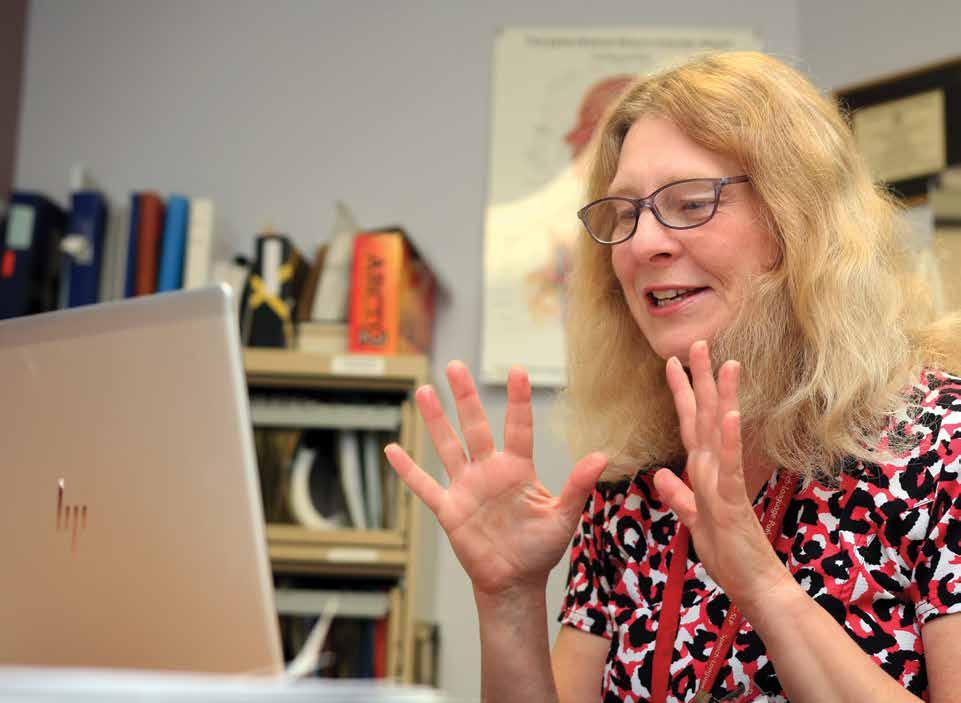
While St. Joseph’s gradually reintroduces in-person visits, many St. Joseph’s patients continue to receive care, education and therapy without leaving home. Various technologies and online resources are being tapped with excellent results and appreciative feedback.
“This doesn’t minimize the struggle of those patients we weren’t able to be see during the pandemic, but what teams have been able to do very quickly has been outstanding,” says Glen. “This is a model of care we must and will sustain and enhance post COVID-19.” Important next steps are now underway at St. Joseph’s to ensure reliable, safe and appropriate care using virtual technologies as additional tools to serve patients and their families.
1
For more examples of virtual patient care underway at St. Joseph's, visit:
www.sjhc.london.on.ca
THE COVID-19 SILVER LINING
65%
Daily weekday percentage of total appointments that were virtual during the peak of the pandemic, up from about 6% pre-pandemic
1000
Daily weekday average of virtual care appointments during the peak of the pandemic, compared to 160 a day pre-pandemic.
CARE AND COMPASSION BRIDGES DISTANCE AND SPACE
Patients of St. Joseph's Health Care London appreciate powering up and tuning in to connect with their care teams through virtual technologies.
AN OVERWHELMING SENSE OF RELIEF - BETH MILLER
In early January, Beth Miller experienced a brain bleed that left her with significant mobility loss. For this athlete and mother of three, the aftermath was devastating.
After three weeks as an inpatient at St. Joseph’s Parkwood Institute, Beth graduated to outpatient rehabilitation. But after just one in-person visit with a physiotherapist, the pandemic struck, leaving Beth frightened, not knowing what to do next. But with an overwhelming sense of relief, Beth began working with her physiotherapist via videoconferencing.
— BETH MILLER, PATIENT THROUGH ST. JOSEPH'S COMPREHENSIVE OUTPATIENT REHABILITATION PROGRAM
NO LOSS OF VALUE - JOHN HODGKINSON
When the pandemic began, John Hodgkinson joined a group education session with others living with chronic obstructive lung disease (COPD). But not to worry – John was the only person in the room. All were tuning in by phone.
Not only does the 70-year old see no downside to this virtual gathering, he thinks it’s “fabulous.”
Physiotherapist Darlene Vandesompele engages with a patient in a virtual rehabilitation therapy session.
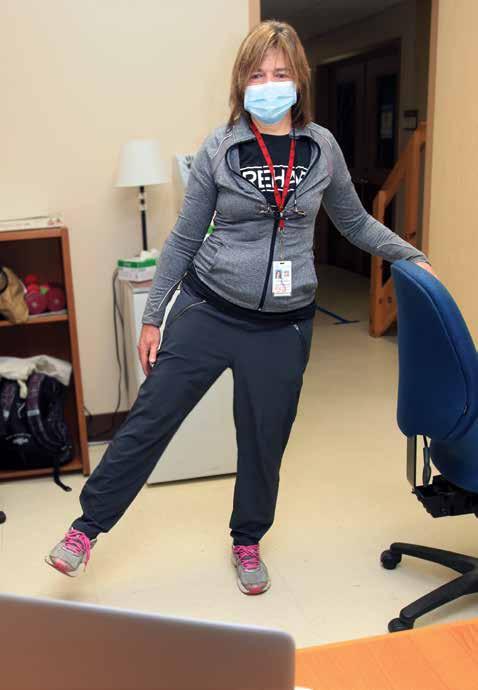
“There has been no loss of value,” says John, a patient of St. Joseph’s COPD and Pulmonary Rehabilitation Program. “They stumbled upon something extremely good and efficient. I see nothing but positives.” ...continued
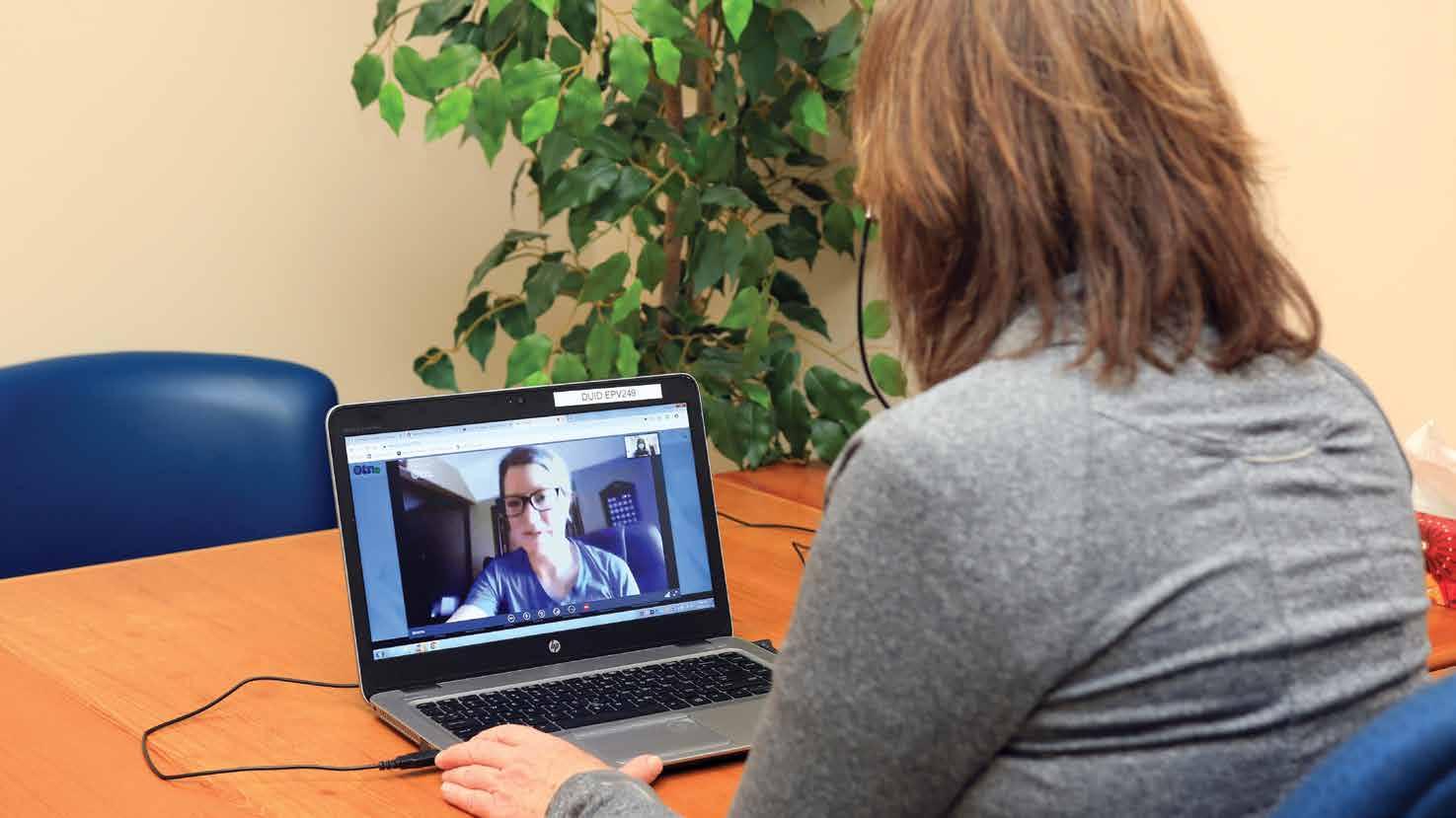

— JANET JENKINSON, ROBERT JENKINSON'S WIFE
Stroke survivor Robert Jenkinson, an outpatient receiving care from Parkwood Institute's Community Stroke Rehabilitation Team, takes part in a virtual rehabilitation session as he and his wife peer into a computer monitor from the comfort of their own home.
A VIRTUAL LIFELINE - ROBERT JENKINSON
When Robert Jenkinson began virtual sessions with St. Joseph’s speech language pathologist Debra Medzon, he couldn’t talk. A faint whisper – almost inaudible - was the extent of his verbal communication.
After suffering a stroke in March, Robert spent weeks at Parkwood Institute receiving inpatient stroke rehabilitation. As COVID-19 began to ramp up, the 77-year-old was discharged and transitioned to St. Joseph’s Community Stroke Rehabilitation Team. Then everything stopped.
Through videoconferencing technology, however, Robert, with help from his wife Janet, began receiving speech language therapy virtually. Today, he is speaking clearly, in full sentences, and his voice continues to get stronger.
“It’s been a virtual lifeline,” says Janet. “If I was the sole caregiver to help Robert with his speech, the outcome may have been quite different.”

FIGHTING THE STORM - MARIE-FRANCE VERMETTE
For Marie-France Vermette, a daily swim was helping to keep chronic pain in check. When the world stopped and the pool closed with the pandemic, her pain flared.
A patient of St. Joseph’s Pain Management Program, Marie-France says her care team didn’t miss a beat. She has been receiving virtual one-on-one therapy and group education, calls from her St. Joseph’s physician and pharmacist, and regular emails and e-newsletters with tips and resources for self- management.
— MARIE-FRANCE VERMETTE, A PATIENT OF ST. JOSEPH'S PAIN MANAGEMENT PROGRAM
1
For more examples of virtual patient care underway at St. Joseph's, visit:
TREATMENT FOR PREMIES HOLDS PROMISE FOR ADULTS WITH COVID-19
Researchers at Lawson Health Research Institute are investigating a new treatment they hope will improve COVID-19 outcomes and reduce the time patients with severe cases must spend on mechanical ventilation. It’s called bovine lipid extract surfactant suspension (BLES®).
Surfactant is a substance that consists of lipids and proteins, and is naturally produced in the lungs of healthy individuals. Its primary function is to reduce surface tension in the alveoli, helping us to exchange gases and breathe more efficiently. Alveoli are tiny, balloonlike air sacs that exchange oxygen and carbon dioxide to and from the bloodstream. When there is less surfactant being produced, or the surfactant is dysfunctional, alveolar walls can stick together, making it difficult to breathe.
Recent lung analyses from patients with severe COVID-19-induced respiratory failure indicate there is a change in their alveolar type-II cells – the cells that secrete surfactant. This suggests a change to the surfactant being produced and a decrease in its functional efficacy.
Lawson scientists Dr. Ruud Veldhuizen and Dr. Jim Lewis are studying whether the use of BLES®, an exogenous surfactant, given at the time of intubation can improve gas exchange, reduce the need for mechanical ventilation, decrease systemic inflammatory response, and shorten the length of intensive care and hospital stays for patients with severe COVID-19.
BLES® is a pulmonary surfactant manufactured in London by BLES Biochemicals. It is currently used worldwide to help improve lung function in premature babies, saving the lives of many infants suffering from neonatal respiratory distress syndrome.
Drs. Ruud Veldhuizen, left, and Dr. Jim Lewis, scientists at Lawson Health Research Institute, are leading research to determine whether a London-made substance used to treat respiratory distress in preemie babies can help treat lung complications triggered by COVID-19.

Researchers are confident it will also help adults who develop lung disease and acute respiratory distress syndrome (ARDS).
“BLES® has been studied in pediatric and adult populations with ARDS and we have found that it improves outcomes in patients with direct lung injury when compared to patients receiving standard treatment,” explains Dr. Lewis, a respirologist at St. Joseph’s Hospital. “COVID-19 seems to be another prototypic case that we think will respond well.”
Mechanical ventilation, while sometimes necessary, can cause damage to the lungs, adds Dr. Veldhuizen. “In previous studies, we’ve been able to show that if you give the surfactant early, prior to ventilation, you can prevent some of this damage from occurring.” The world is focused on finding good treatments for COVID-19, say the researchers. This kind of research is made possible through strong partnerships and collaboration in London. Many experts are involved, including scientists and research staff, physicians, nurses, respiratory therapists, pharmacists, and staff at BLES® Biochemicals.
A London-made bovine lipid extract surfactant suspension (BLES) is being tested by scientists at Lawson Health Research Institute to improve the outcomes of critically ill COVID-19 patients.

WHEN THE WORLD CHANGED
The role of St. Joseph’s Health Care London in the region’s COVID-19 response has been extensive, including caring for the most vulnerable.
Suddenly, the world changed and the critical rush for hospitals was to make room for a potential surge of patients. They had to mobilize, and fast. COVID-19 was here.
This meant pausing scheduled services and creating space in hospital inpatient units by opening new beds and discharging patients to long-term care or home if it was safe to do so. St. Joseph’s responded swiftly, efficiently, expertly.
“As a provincial leader in providing rehabilitation and recovery care for patients, we are uniquely positioned,” says Roy Butler, Vice President of Patient Care and Risk Management at St. Joseph’s. “At Parkwood Institute, we are often the bridge for patients transitioning from acute care back to home or the community and it made sense for us to expand this role in the regional response to COVID-19.”
But opening a new bed in a hospital inpatient unit is complex, explains Roy. “One of the most important considerations was whether or not we had the people power to provide safe care for patients, including members from various health care disciplines.”
Hannah Bear, left, Rebecca Kozak, Mark King, and Justin Simas were among many on the frontlines at Parkwood Institute playing an essential role during the pandemic.

Despite the challenges, St. Joseph’s opened a total of 85 beds in the early weeks of COVID-19:
73 new beds at Parkwood Institute Main Building, mostly to care for patients who no longer need acute level services, or are awaiting long-term care and cannot be safely sent home.
12 new beds at Parkwood Institute Mental Health Care Building for adult mental health patients who have experienced functional decline in the community, and patients from acute care facilities. At the height of the pandemic, Parkwood Institute Main Building partnered with acute care hospitals such as London Health Sciences Centre and accepted more than 50 transferred patients.
“Being hospitalized can be difficult for patients, especially frail seniors,” says Elizabeth McCarthy, St. Joseph’s Director of Specialized Geriatric Services. “We recognized a need for many of these individuals to have their own properly fitted devices to help them stay mobile, such as wheelchairs and walkers.”
Many of the patients could not afford to purchase their own devices, so a team at St. Joseph’s worked with local volunteer service clubs that repurpose donated wheelchairs and walkers to find devices for each patient, not just for use at Parkwood Institute but to take with them when discharged.

One patient, Jerry Brennan, expressed his gratitude in a letter to the team.
“Having a wheelchair allows me the opportunity for increased independence…to exercise and maintain my strength. I have a great love for nature and feel blessed to have a window with a beautiful view of the back garden at Parkwood (Institute). This is more than just a wheelchair to me. It’s my key to happiness.”
Rehabilitation therapists Rebecca Kozak, left, and Hannah Bear prepare beds at Parkwood Institute Main Building at the height of the pandemic.
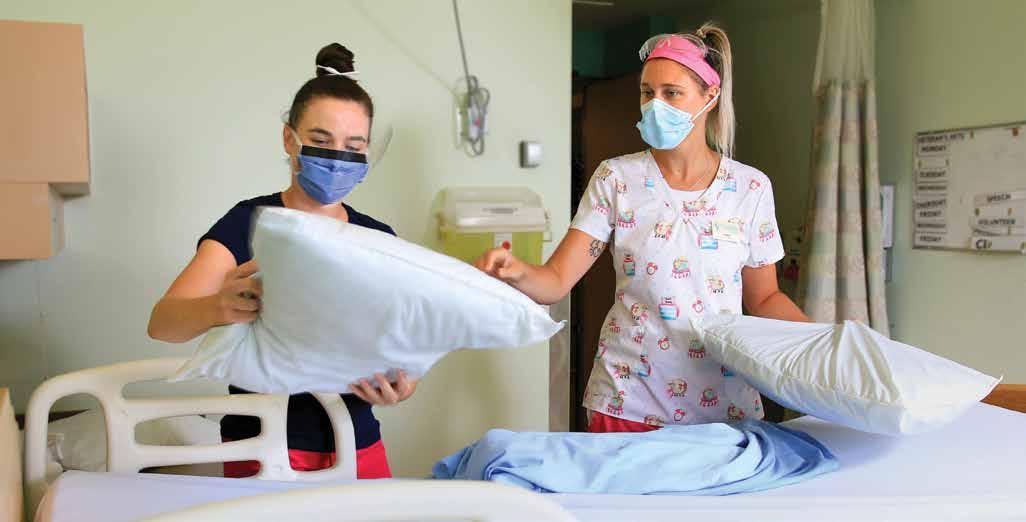
MOBILIZING MANPOWER, BEDS, INGENUITY AND EXPERTISE
The role of St. Joseph’s Health Care London and Lawson Health Research Institute during the pandemic has been critical and far-reaching.
ST. JOSEPH’S CEO is the lead for South West regional pandemic planning .
80%
of Ontario's COVID-19 tests are completed through Pathology and Laboratory Medicine of St. Joseph's and London Health Sciences as part of a consortium of Ontario hospitals and public health lab operations. The role of St. Joseph’s Health Care London and Lawson Health Research Institute during the pandemic has been critical and far-reaching.
NEARLY 30
promising COVID-19-related projects by Lawson researchers have been initiated or are set to begin at St. Joseph's focusing on diagnosis, prevention, treatment and mental health impacts of COVID-19.
34 STAFF were deployed to support assessment and testing at COVID-19 community assessment centres in London.
173 staff were deployed to various care areas at St. Joseph’s during the pandemic.
MORE THAN 85 beds opened across St. Joseph’s to manage a potential surge of COVID-19 cases in London.
NEARLY 130 students were hired on a temporary basis and working within 24-28 hours to screen for COVID-19 at St. Joseph’s entrances.
YEAR OF THE NURSE

The World Health Organization designated 2020 as ‘Year of the Nurse and Midwife’ in honour of the 200th anniversary of the birth of Florence Nightingale, founder of modern nursing. St. Joseph’s Health Care London is proud to celebrate the more than 1,400 nurses providing quality-focused, compassionate care across the organization. Working in a wide-variety of roles and programs, they share their passion for the nursing profession in the following reflections:

MIRELLA O’NEIL, REGISTERED PRACTICAL NURSE, STEELE STREET REHABILITATION RESIDENCE
Q: WHAT IS MOST REWARDING ABOUT WORKING WITH PATIENTS DURING THEIR TRANSITION TO THE COMMUNITY?
A: My nursing career began in 1985 on the Adolescent Unit of the London Psychiatric Hospital. Today, I have the opportunity to support mental health care clients as they re-integrate back into the community. I find great satisfaction in watching my clients’ lives improve significantly. Mental health care nursing is a profession where one person can have a profound effect on another’s life. That is how I view my career today, and how I have looked at every shift for 35 years.
PATRICK PENNACCHIETTI,REGISTERED PRACTICAL NURSE, ASSESSMENT UNIT, SOUTHWEST CENTRE FOR FORENSIC MENTAL HEALTH CARE
Q: WHAT ADVICE DO YOU HAVE FOR NURSES JUST STARTING THEIR CAREER?
A: I would remind them they have chosen a career in which they can truly make a difference in someone’s life. For some, a hospital stay can be a traumatic time and it is our job to ease this discomfort to the best of our ability. It is important to truly listen to the patient and show empathy toward their current circumstances. It is also important to lead by example and provide the best care possible. A positive attitude is contagious and you could be the person who makes a difference in the care being provided by others.
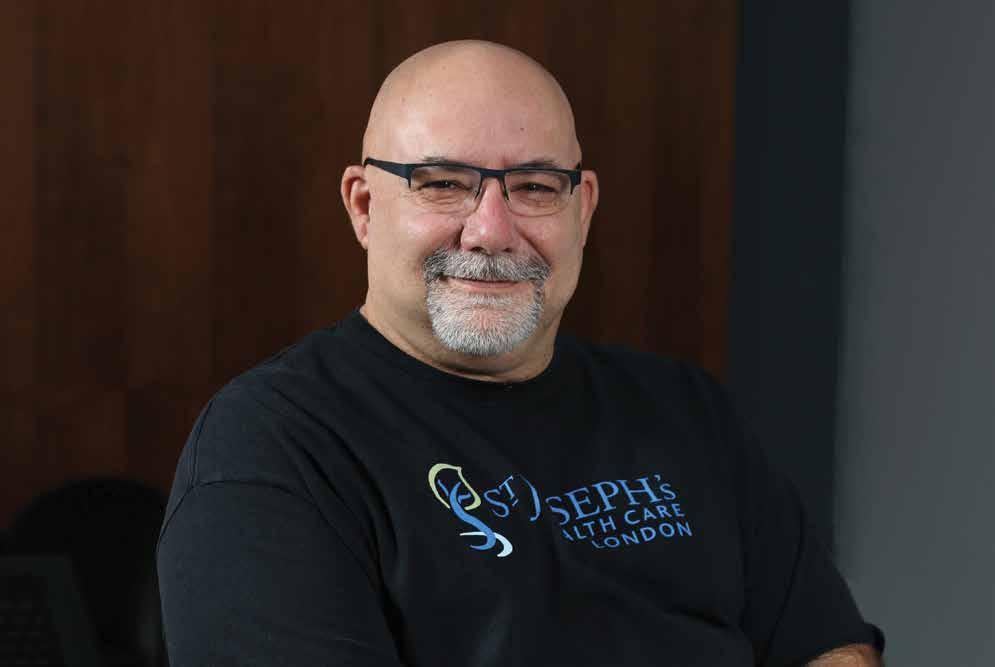
STEVEN MACGREGOR, REGISTERED NURSE, HEART FAILURE CLINIC, ST. JOSEPH’S HOSPITAL
Q: WHAT DREW YOU TO YOUR ROLE IN CARDIAC CARE?
A: Because I’ve been fortunate to have a wide variety of nursing experiences over the past 24 years, cardiac care was not foreign to me. St. Joseph’s Heart Failure Clinic was a new opportunity that sparked my curiosity and humbled my outlook on health care. Having an opportunity to blaze new trails in nursing was appealing and is concurrently challenging. I feel extremely proud of what our team at St. Joseph’s represents.
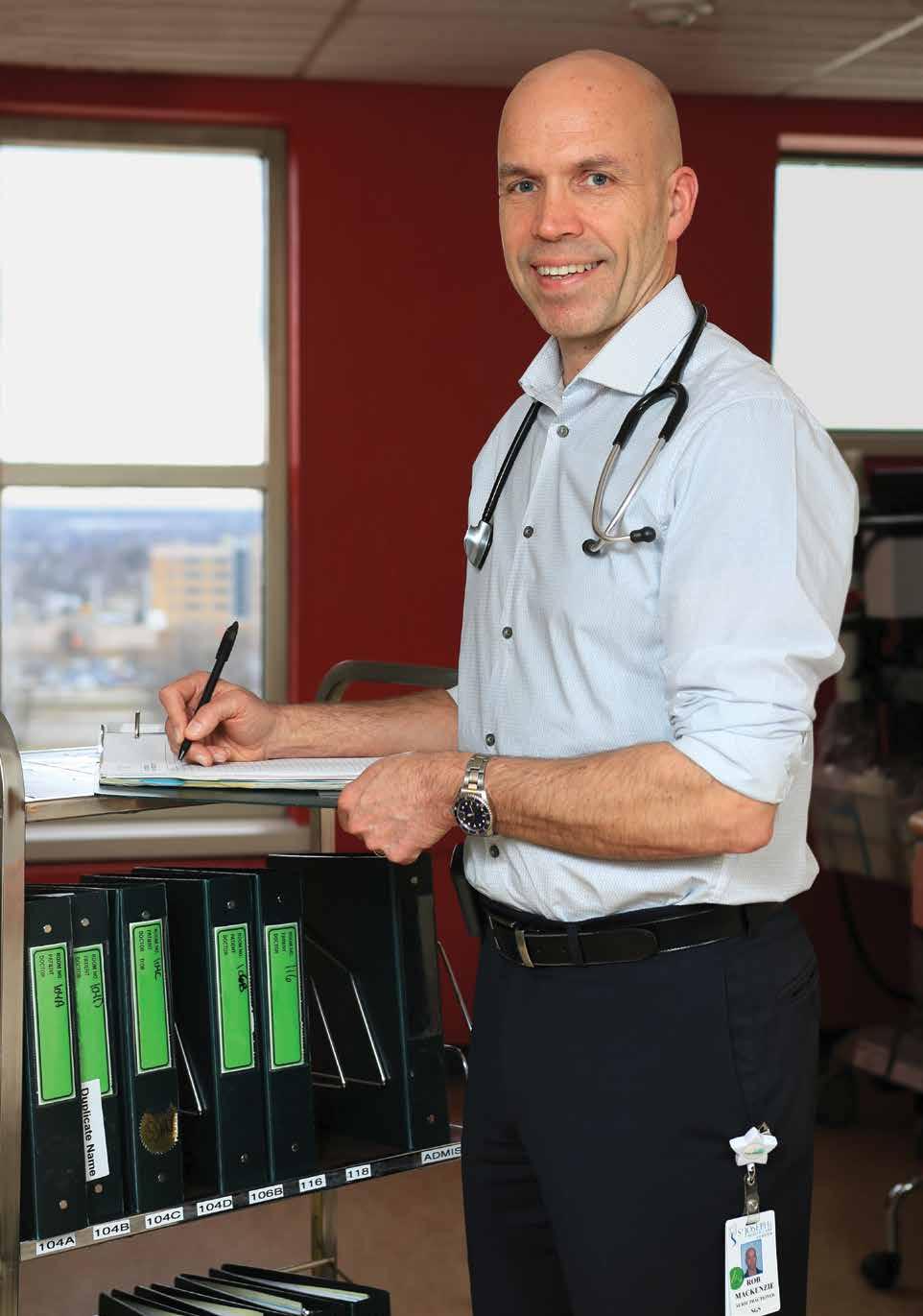
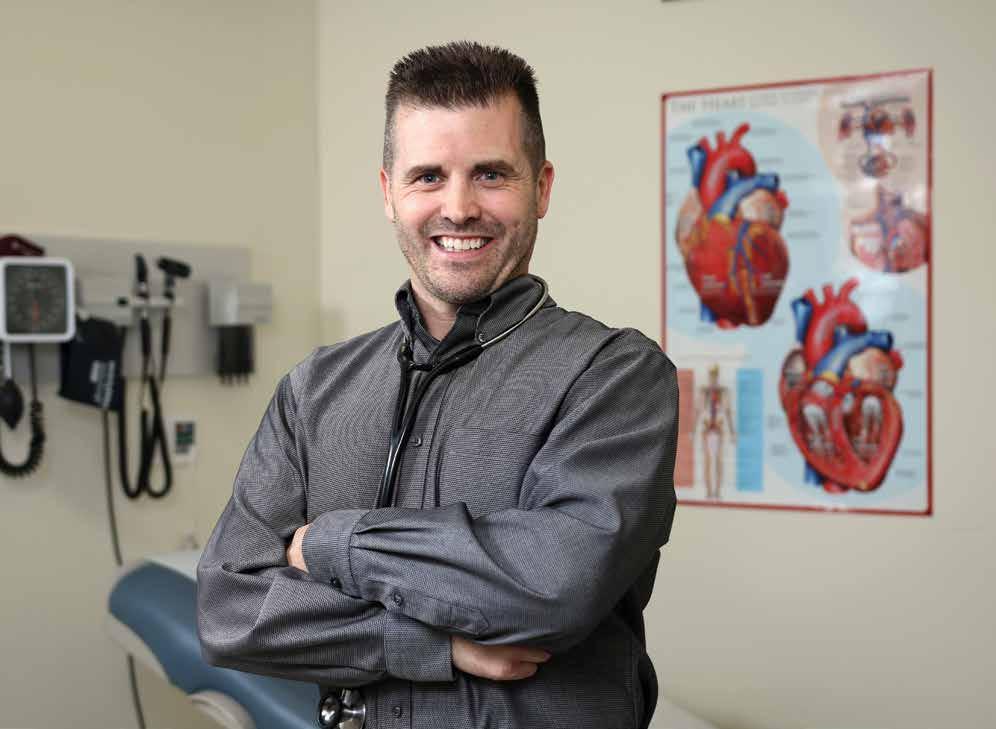
ROB MACKENZIE, NURSE PRACTITIONER, SPECIALIZED GERIATRIC SERVICES, PARKWOOD INSTITUTE
Q: WHAT INSPIRED YOU TO BECOME A NURSE PRACTITIONER?
A: From the beginning of my career, I was motivated to take nursing as far as I could in the clinical domain. I had been working for 10 years as a registered nurse when I learned about the advanced practice nursing role, which provided the opportunity to work closely with patients and families. I was looking to pursue a Master’s degree in nursing when the nurse practitioner (NP) program was re-launched by the provincial government. My Master’s, alongside the NP certification, complemented each other quite nicely and allowed me to take my nursing skills to a higher level that would benefit my patients in a substantial way. I was fortunate that an NP position was created in our Geriatric Rehabilitation Program – the first inpatient NP position at Parkwood Institute – where I work to this day.

Health care workers across the globe have rallied to meet the needs of their communities, and it is no different in London, Ontario. At St. Joseph’s Health Care London, staff and physicians have been wearing masks for many months to protect patients and residents and each other as they answer the call during this crisis.
The mask is a necessity yet it covers faces, moods and expressions, leaving people to wonder – who’s behind the mask? Behind The Mask tells the stories of health care workers in all roles and disciplines at St. Joseph’s, allowing a glimpse into the lives of those who care for our community.
EMILY MCCARTHY MUSIC THERAPIST
Emily McCarthy has always turned to music during difficult times, and COVID-19 has been no different. “Every day I see how it has helped me personally and the veterans I work with.”

During this crisis it has been important for Emily to feel a sense of purpose. “Knowing my purpose is to support the veterans and residents I work with has kept me motivated. My team has been amazing. I am grateful every day I get to come to work, do what I love, and lift people’s spirits with music.”
In Emily’s program, one of the most challenging issues has been the inability of families to visit their loved ones. “This has been very hard for residents. We have been able to connect residents and families through video calls. It’s not the same as an in-person visit, but it instantly brightens the resident’s mood and it’s reassuring for families to see their loved ones healthy.”
Emily recognizes the many obstacles the health care community has faced. “I feel it’s okay to be discouraged at times, but I’m reminded that we are in this together. We are blessed to have the capacity to make a positive impact every day, and that gives me inspiration.”
— EMILY MCCARTHY, MUSIC THERAPIST
DR. MICHAEL SILVERMAN CITYWIDE CHAIR/CHIEF OF INFECTIOUS DISEASES
Dr. Silverman has played an instrumental role in London’s response to the pandemic while providing clarity in a world filled with noise about COVID-19. His leadership and knowledge in infectious diseases has been sought nationally, and is one of the reasons London has been able to weather the storm so far.
Dr. Silverman, who is also the Medical Director of St. Joseph’s Infectious Diseases Care Program
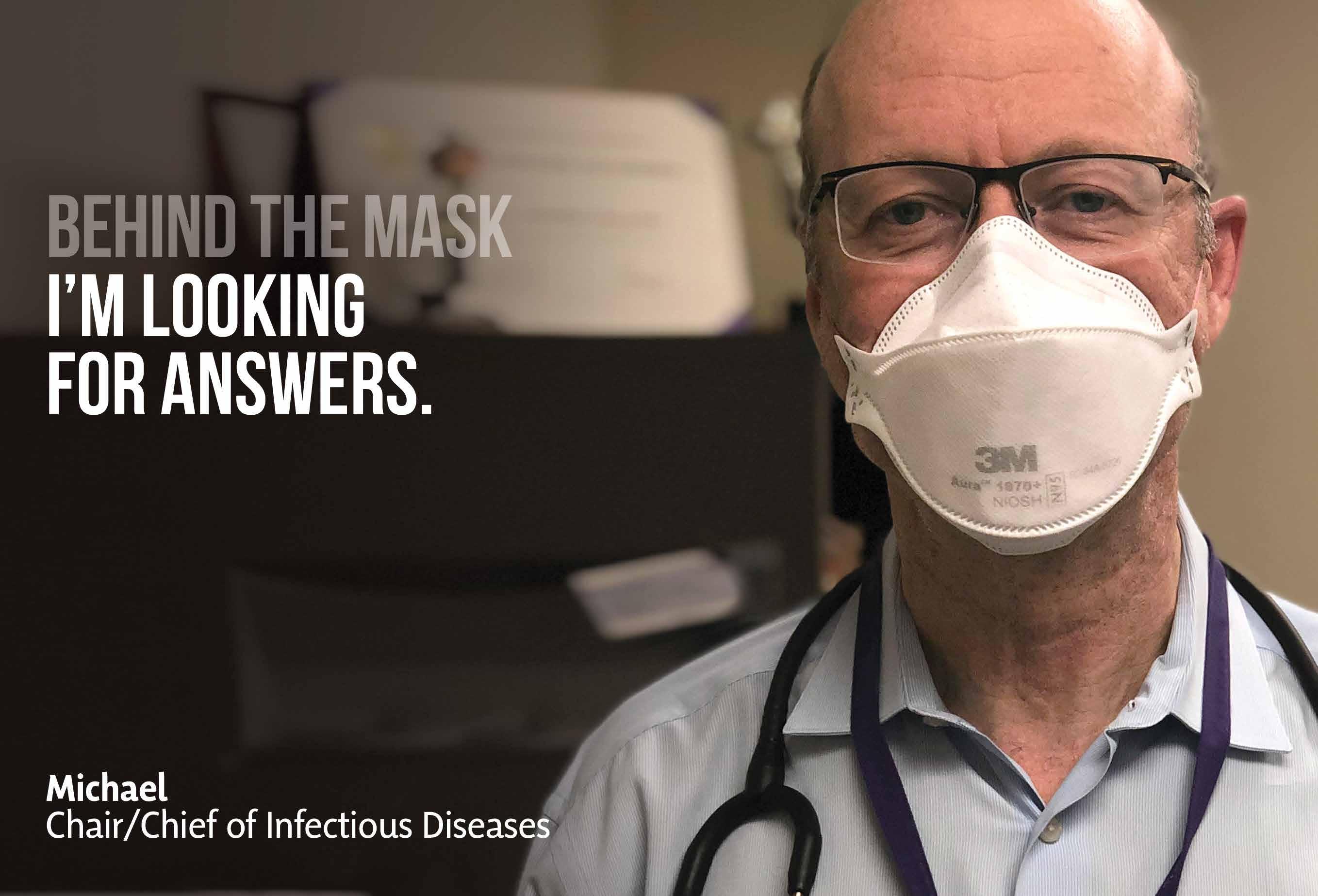
and a scientist at Lawson Health Research Institute, feels a strong sense of compassion for those afflicted by COVID-19. It’s what motivates him to keep going when he’s feeling worn out. “The work has been exhausting but we can’t let our guard down. The virus won’t get tired.”
Always the voice of reason and calm, Dr. Silverman reassures everyone the pandemic will eventually end.

— DR. MICHAEL SILVERMAN, CITY WIDE CHAIR/CHIEF OF INFECTIOUS DISEASES
...continued
KAREN PERKIN VICE PRESIDENT PATIENT CARE AND CHIEF NURSE EXECUTIVE
Karen Perkin stepped into the role of St. Joseph’s COVID-19 Incident Manager when the pandemic struck. Her strong leadership pulled the organization through this historic time, never losing sight of what is most important and just how close the battle is for so many.
“For me COVID-19 has a face. My neighbour, who contracted the virus, succumbed to the illness. Every day I leave my house, I look across the road and understand what we are fighting for.”
For Karen, the virus has highlighted the need for extra work and diligence around vulnerable people and patients, including those living in long-term care.
“Long-term care residents are living longer and have very complex care needs and conditions. It is time our attention turns to those most vulnerable who have been clearly targeted during this crisis and who have paid the price dearly.”

DR. VIRAJ MEHTA SITE CHIEF, MENTAL HEALTH CARE PROGRAM
As a psychiatrist, Dr. Mehta, figured he would need to mentally support those close to him during the pandemic – colleagues, family and friends. What he didn’t anticipate was that his family would become a constant source of motivation and support, and his colleagues a wellspring of encouragement as they rose to the challenge of providing exceptional patient care during the pandemic.
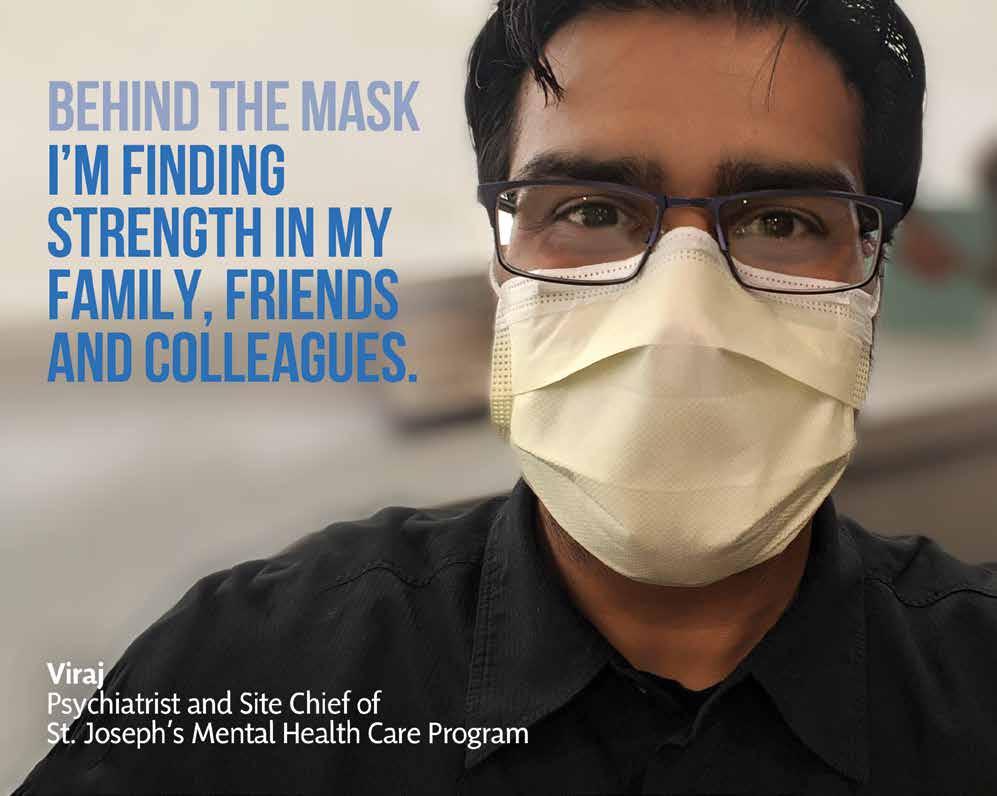
“The way our physicians and staff have responded has been inspirational. Everyone focused on supporting patients and each other, maintaining these two priorities regardless of the challenges we faced. Rather than expressing frustration, they respond by finding opportunities.”
Virtual care has proved to be an important tool to support patients and families at this time of physical distancing, with many patients continuing to be seen virtually.
“It is extraordinary how well patients have adapted to the circumstances. We have seen patients demonstrate their capacity for recovery and many have maintained, or made progress, despite the pandemic.”
LISA ROSELLI RECREATIONAL THERAPIST, MOUNT HOPE CENTRE FOR LONG TERM CARE
Lisa wants residents to see her smile again. As a recreational therapist at Mount Hope Centre for Long Term Care, she works with vulnerable people, many of whom have dementia. Sometimes a smile is all it takes to put those in her care at ease and make them feel comfortable. “Wearing a mask means that people cannot see when we’re smiling. We’ve had to become creative and find new ways to make our residents smile and laugh.”
Visitor restrictions have made it challenging for family members to see loved ones in long-term care facilities. It’s a challenge that motivates Lisa. It’s the reason why she facilitates weekly video visits to keep residents connected with family members.
“Donations through St. Joseph’s Health Care Foundation have funded iPads and other technology that enable residents to stay connected with loved ones. It has been heartwarming and a lot of wonderful moments have come from these conversations.”
The lack of face-to-face communication has also been tough for the therapeutic recreation team who like to work collaboratively and bounce ideas off each other. “Video, phone and email chats just aren’t the same as being in the same room and feeling the energy and excitement of new ideas.”
The past few months have not been easy for Lisa. But she wants you to know that underneath the mask, she’s still smiling.
1
You can read more stories from Behind the Mask on our website at:
www.sjhc.london.on.ca/ behind-the-mask
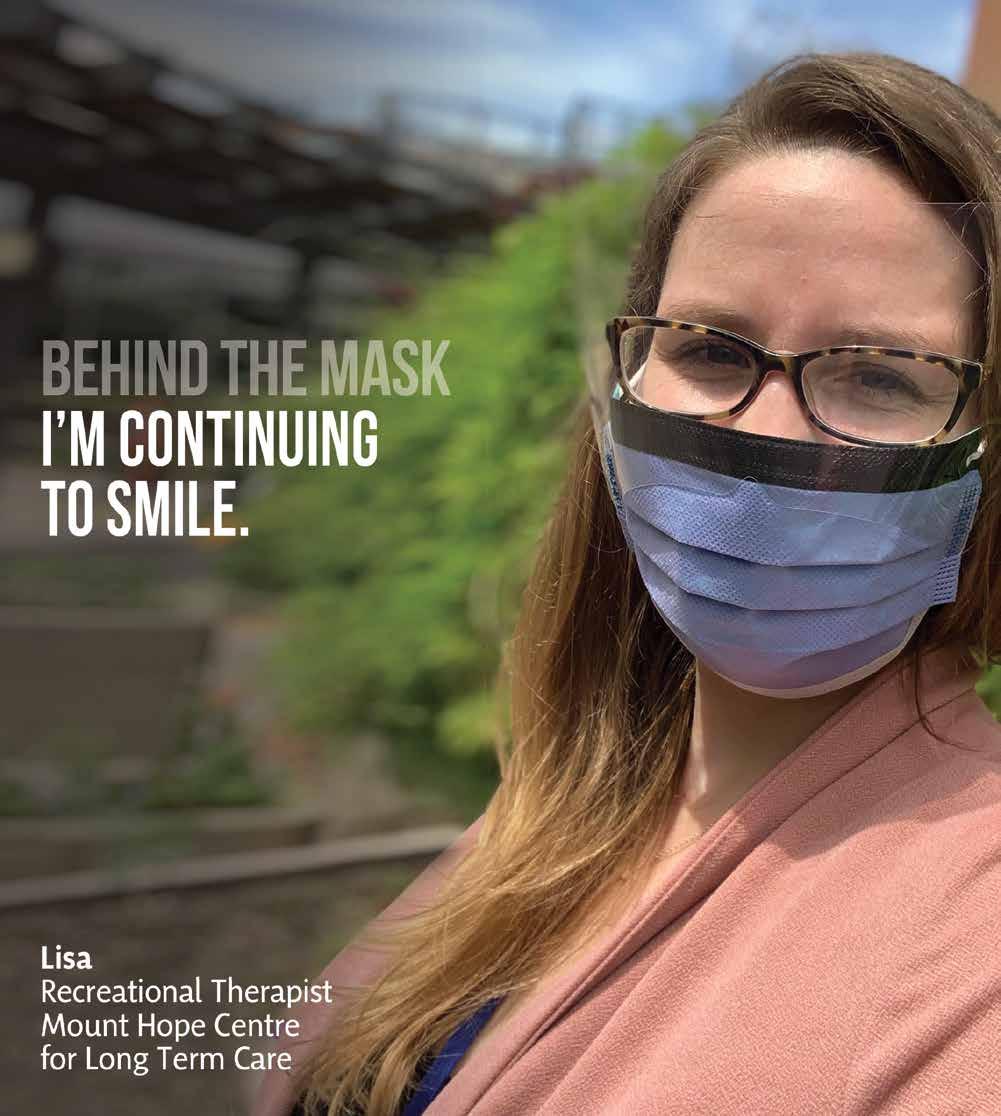
Blue lights in support of health care workers wrap around St. Joseph’s Southwest Centre for Forensic Mental Health Care.
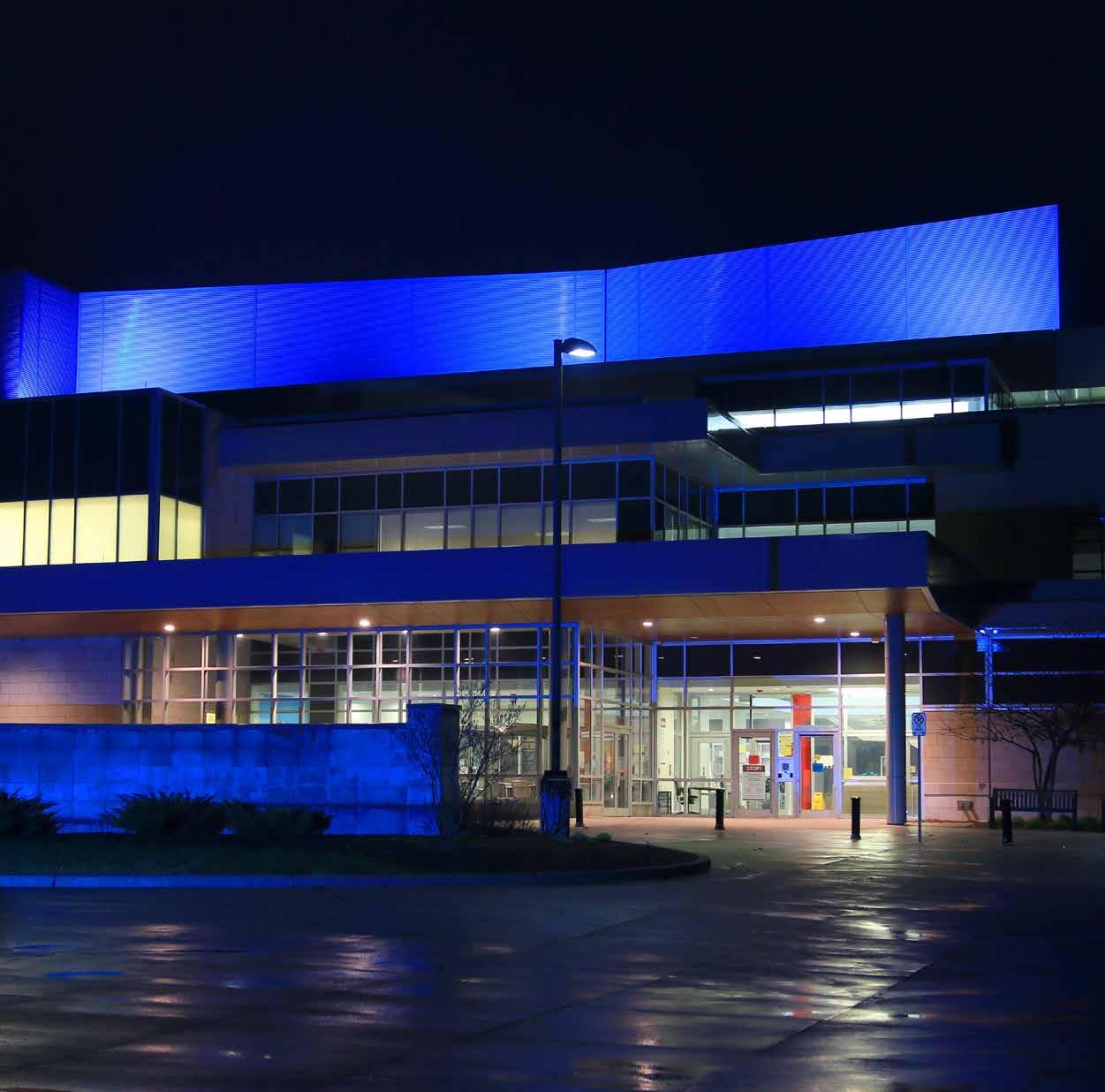
SHINING A LIGHT ON HEALTH CARE HEROES
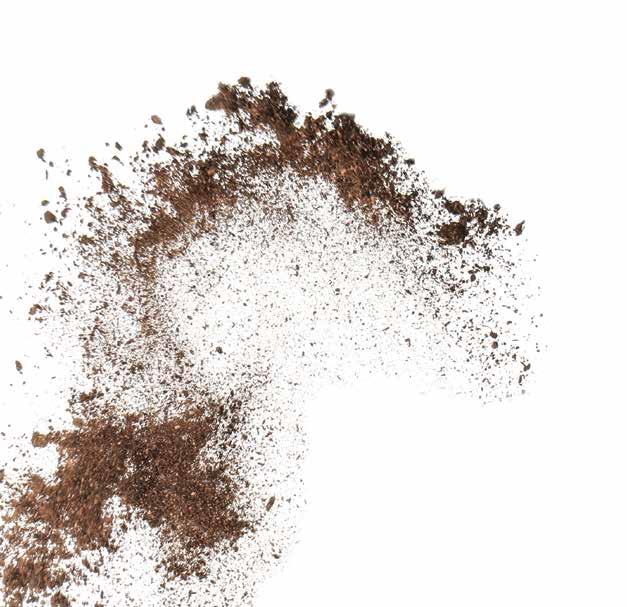
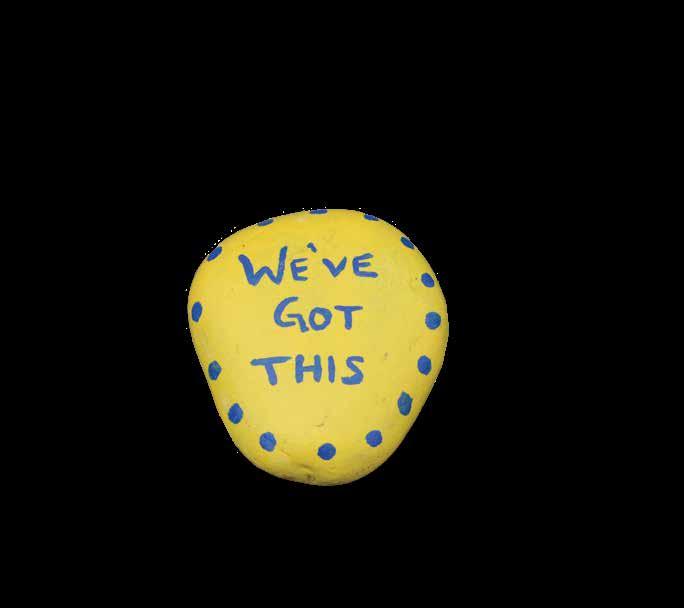
Community support for health care workers at St. Joseph's Health Care London and across London has been unwavering during this unprecedented time. From words of encouragement displayed throughout neighbourhoods, to ‘thank-you’ convoys of vehicles circling our sites, to generous donations of supplies, services and dollars, and delivery of treats and food – such acts of kindness are a symbol of togetherness that strengthen our resolve and propel us forward. As a way to show solidarity and recognize every health care worker in the community, St. Joseph’s sites were bathed in blue lights every night during the height of the pandemic. From labs, nursing homes, hospitals, family physician offices and more, St. Joseph’s appreciates the dedication of all those on the frontlines and behind the scenes working to provide care and keep people safe.

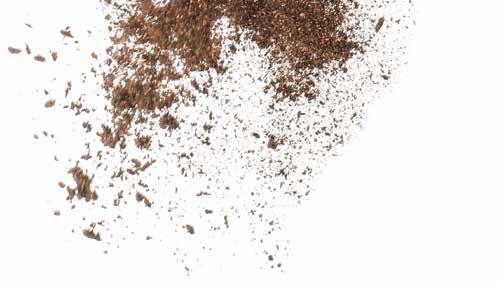

A heartwarming gesture from emergency responders: In a colourful convoy, London Police Services, London Fire Department and London Paramedics drive past St. Joseph’s Hospital on April 1 - a touching tribute in honour of health care workers during the COVID-19 pandemic.

Blue lights in support of health care workers shine brightly at Mount Hope Centre for Long Term Care. Staff wave and cheer as a procession of emergency vehicles drive past St. Joseph's Hospital with flashing light and blaring sirens.

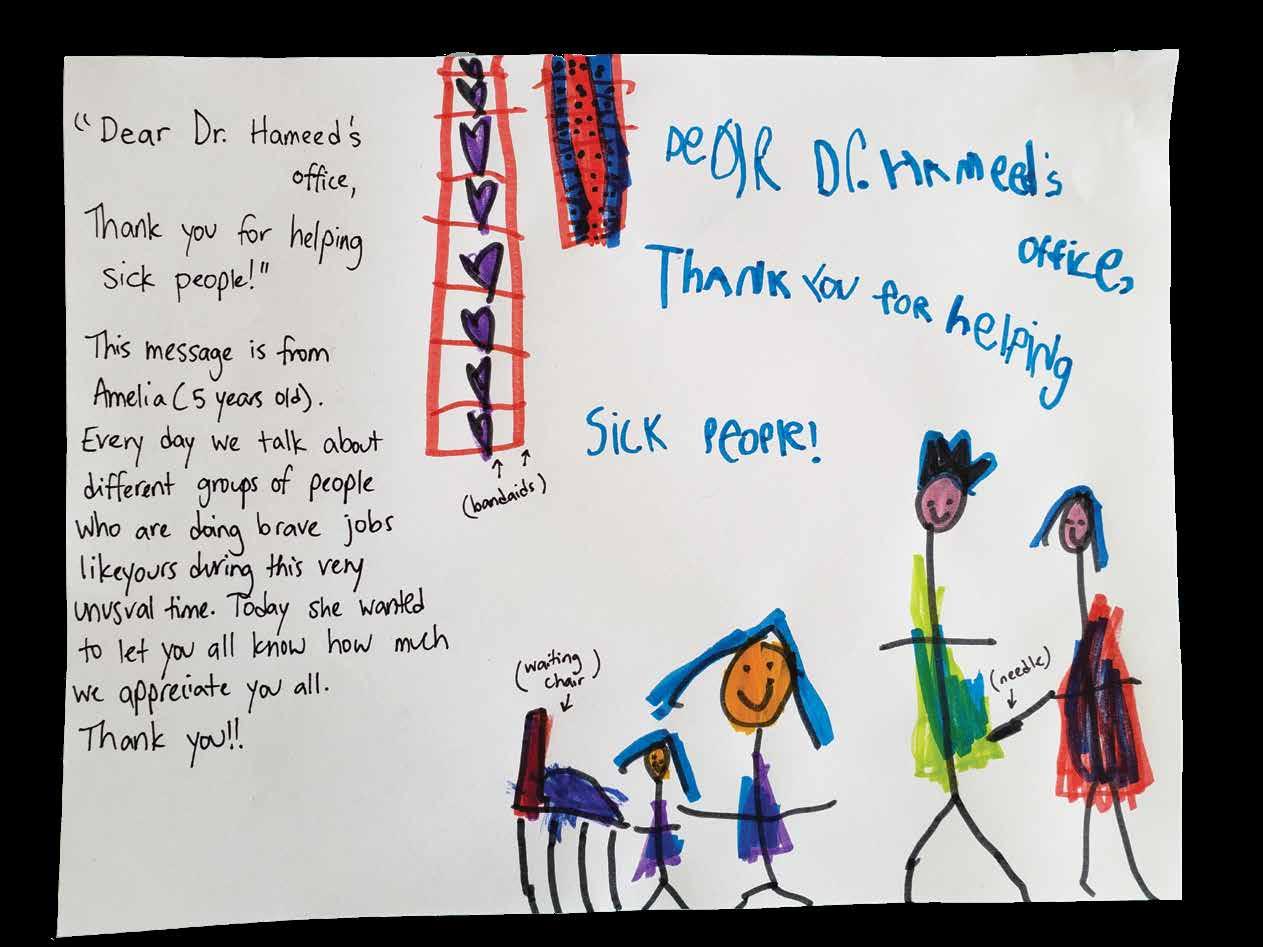
A hand-written note from five-year-old Amelia lets Dr. Saadia Hameed and staff at St. Joseph’s Family Medical and Dental Centre know she appreciates the important work they do.
St. Joseph’s Health Care London provides care through an extremely unique mix of clinical settings – making us one of the most complex health care organizations in Ontario. In a continual effort to bring the best care possible to those we serve, we constantly engage patients and their families, leaders, physicians, staff, volunteers, donors and many partners to ensure St. Joseph’s takes innovative steps in addressing the health care needs of our community, now and in the future.
MY ST. JOSEPH’S IS
St. Joseph’s Hospital Parkwood Institute
Mount Hope Centre for Long Term Care Southwest Centre for Forensic Mental Health Care
Teams, clinics and programs in our community and beyond.
SHARE YOUR FEEDBACK OR STORY WITH US
St. Joseph’s Health Care London PO BOX 5777, STN B London, ON N6A 4V2 519 646-6100 ComDept@sjhc.london.on.ca
